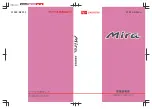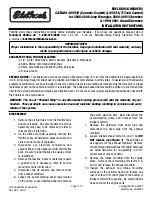
Optional Belted Tires
Because of the stiffening belt under
the tread, the ride characteristic may
be somewhat different than that ex-
PART NO.
TIRE SIZES & PLY RATING
TIRE PRESSURES
STANDARD
COOL HOT
UPTOVEHICLE
FRONT
m
i s
LOADLIMIT
REAR
Q
Q
OpT|ONAL`
ITUSPASS.
_FRONT
Q
[ 3
(
Las.)
REAR
I I]
Z
VEHICLE CAPACITY
BENCH
BUCKET
SEAT
SEAT
OCCUPANTS
C1
I: I
\:| FRONT
\:| FRONT
:I REAR
\:| REAR
TRUNK LOAD
E LB S.
\: LBS.
TOTAL
I=I LBS.
I=I LBS.
See Owners Manual For
Additional Information
PRINTED IN U.S.A.
perienced with conventional tires.
Follow the inflation pressures recom-
mended in this OWner's Manual.
To achieve best all around vehicle
Inflation Pressure
To ensure the proper tire inHation
pressure for your particular require-
ments,
follow the
recommendations
on the tire placard affixed to the left
door of your vehicle. A typical plac-
ard
is shown here.
The
placard
on
the door specifies the size and ply of
1. Tire inflation pressures may increase
as much as six (6) pounds per square
inch (PSI) when hot.
2. For continuous high speed operation
(over 75 MPH) increase tire inflation
pressure 4 pounds
per square inch
over the recommended pressures up
to a maximum of 32 pounds per square
inch cold for 4 ply rating tires, or 40
pounds per square inch cold for 8 ply
tires. Sustained speeds above 75 mph
are not
recommended
when the 4
pounds
per square
inch adjustment
would require pressures greater than
the maximums stated above.
3. Cold tire inflation pressure: after ve-
handling performance, belted tires,
and conventional tires should not .b'e
mixed on, the same car.
the
tires installed on your vehicle,
plus the recommended tire pressures,
and capacity
of your vehicle. Keep
tires properly inflated, and check in-
Hation pressure at least monthly.
This will ensure you of the best tire
life and riding comfort over the full
range of normd driving conditions.
hicl.e
has been inoperative for three
(8) hours or more, or driven less than
one (1) mile.
Hot tire inflation pressure: after vehi-
cle has been driven ten
(10) miles or
more at 60-70 MPH.
4.
Station Wagon
loads should be dis-
tributed as far forward as possible.
5. Vehicles with luggage racks do not
have a vehicle load limit greater than
specified.
6. When towing trailers, the allowable
passenger and cargo load
must be
reduced by an
amount equal to the
trailer tongue load on the trailer hitch.
59
Содержание Chevrolet CAMARO 1969
Страница 1: ......
Страница 87: ... NOTES ...
Страница 88: ...NOTES ...
Страница 89: ...NOTES if ...
Страница 90: ...NOTES ...
Страница 92: ...C 1 LITHO IN U 4 _ 4 _ _ _ 44 Au ...
















































